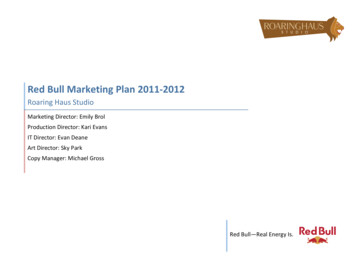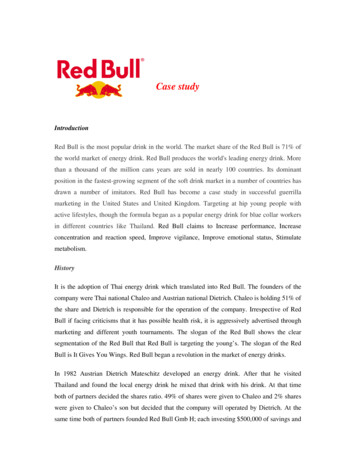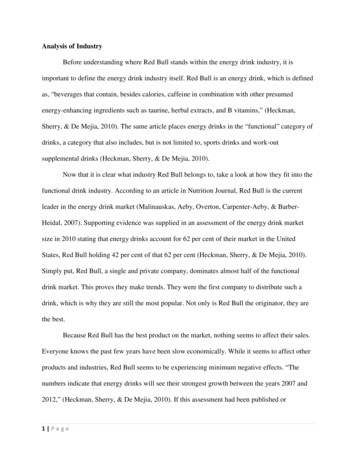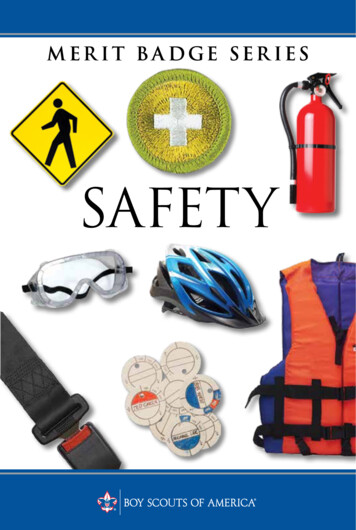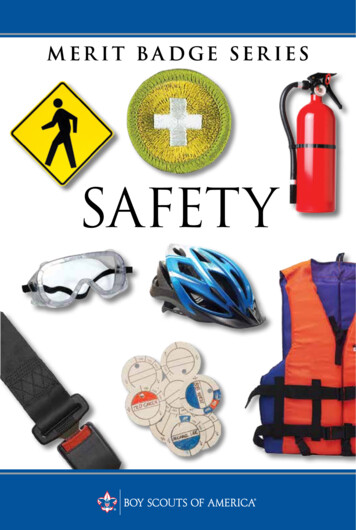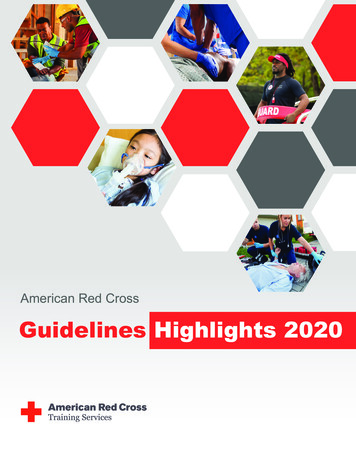
Transcription
American Red CrossGuidelines Highlights 2020
Resuscitation SuiteBLS, ALS, PALSYou Now Have a Choicein Resuscitation EducationHealthcare providers now have a scientifically equivalent and educationallysuperior choice from the first provider of resuscitation and first aid trainingin the United States.Flexible Learning That’s ScientificallyEquivalent and Educationally SuperiorAmerican Red Cross Resuscitation SuiteTM courses deliver the sciencethat will save lives while streamlining the education experience. OurBLS, ALS, and PALS courses will provide the solutions you need whilesaving you time and money. Adaptive learning lets participants test out of sections in BlendedLearning by demonstrating competency. Shorter overall course times resulting from more efficient course designsand personalized learning. Real healthcare providers demonstrate content in real hospital settingswith no gamification. Clinical scenarios specific to those that might be encountered by EMSproviders in field settings. Focus is on critical thinking, decision-making, and team concepts. Online/streaming videos available at no additional cost. Digital student certificate immediately available. Feedback devices recommended but not mandatory. ADA compliant for Blended Learning students. Access Blended Learning on any device—computer, tablet, or mobile.Red Cross courses offer a curriculum based on the same ILCOR scienceand ECC guidelines as other resuscitation courses.A Full Portfolio to Meet All NeedsA better solution ata better price.Go toredcross.org/healthcareto learn more. Certification courses: BLS, ALS, PALS in Instructor-Led and BlendedLearning formats. Streamlined certification course renewal options for experiencedBLS, ALS, PALS providers: Review Option (brief skills review beforetesting) and Challenge Option (test-only).All proceeds from Red Cross training support our lifesaving mission, including disasterrelief, blood collection, and Service to the Armed Forces.263101-30 7/20
The American Red Cross Guidelines Highlights 2020 is overseen by the American Red Cross Scientific Advisory Council and is partof the American Red Cross training services programs. The emergency care procedures outlined in these updates and guidelinesreflect the standard of knowledge and accepted emergency practices in the United States at the time these updates and guidelineswere published. It is the reader’s responsibility to stay informed of changes in emergency care procedures.PLEASE READ THE FOLLOWING TERMS AND CONDITIONS (the “Terms and Conditions”) BEFORE AGREEING TOACCESS, USE OR DOWNLOAD THE FOLLOWING AMERICAN NATIONAL RED CROSS MATERIALS. BY PURCHASING,DOWNLOADING, OR OTHERWISE USING OR ACCESSING THE MATERIALS, YOU ACKNOWLEDGE AND HEREBY AGREETO BE LEGALLY BOUND BY BOTH THESE TERMS AND CONDITIONS AND THE AMERICAN NATIONAL RED CROSSTERMS OF USE (AVAILABLE AT redcross.org/terms-of-use). YOU AGREE THAT THE INCLUDED MATERIALS ARE PROVIDED“AS IS” AND WITHOUT WARRANTIES OF ANY KIND, AND THAT ANY ACCESS TO OR USE OF THESE MATERIALS IS ATYOUR OWN RISK.The following materials (including downloadable electronic materials, as applicable) including all content, graphics, images andlogos, are copyrighted by, and the exclusive property of, The American National Red Cross (“Red Cross”). Unless otherwiseindicated in writing by the Red Cross, the Red Cross grants you (“Recipient”) the limited right to download, print, photocopy anduse the electronic materials, subject to the following restrictions: The Recipient is prohibited from creating new electronic versions of the materials. The Recipient is prohibited from revising, altering, adapting or modifying the materials, which includes removing, altering orcovering any copyright notices, Red Cross marks, logos or other proprietary notices placed or embedded in the materials. The Recipient is prohibited from creating any derivative works incorporating, in part or in whole, the content of the materials. The Recipient is prohibited from downloading the materials, or any part of the materials, and putting them on Recipient’s ownwebsite or any other third-party website without advance written permission of the Red Cross. The Recipient is prohibited from removing these Terms and Conditions in otherwise-permitted copies, and is likewiseprohibited from making any additional representations or warranties relating to the materials.Any rights not expressly granted herein are reserved by the Red Cross. The Red Cross does not permit its materials to bereproduced or published without advance written permission from the Red Cross. To request permission to reproduce or publishRed Cross materials, please submit your written request to The American National Red Cross by going to the Contact Us page onredcross.org and filling out the General Inquiry Form.Copyright 2021 by The American National Red Cross. ALL RIGHTS RESERVED.The Red Cross emblem, and the American Red Cross name and logos are trademarks of The American National Red Cross andprotected by various national statutes.I
Science and Technical ContentThe scientific content and evidence within the American Red Cross Guidelines Highlights 2020 is consistent with the most currentscience and treatment recommendations from: The International Liaison Committee on Resuscitation (ILCOR) The International Federation of Red Cross and Red Crescent Societies The Policy Statements, Evidence Reviews and Guidelines of: American Academy of Pediatrics (AAP) American College of Emergency Physicians (ACEP) American College of Obstetrics and Gynecology (ACOG) American College of Surgeons (ACS) Committee on Tactical Combat Casualty Care (CoTCCC) Obstetric Life Support (OBLSTM) Society of Critical Care Medicine (SCCM) and the American College of Critical Care Medicine (ACCM) Surviving Sepsis Campaign (SSC)DedicationThe American Red Cross Guidelines Highlights 2020 are dedicated to the nurses, physicians, prehospital professionals,therapists, technicians, law enforcement, fire/rescue, advanced practice professionals, lifeguards, first responders, lay respondersand all other professionals and individuals who are prepared and willing to take action when an emergency strikes or when aperson is in need of care. These updates and guidelines are also dedicated to the employees and volunteers of the AmericanRed Cross who contribute their time and talent to supporting and teaching lifesaving skills worldwide.AcknowledgmentsMany individuals shared in the development of the American Red Cross Guidelines Highlights 2020 in various scientific, technical,editorial, creative and supportive ways. Their commitment to excellence made these updates and guidelines possible.II
Content DirectionThe development of these updates and guidelines would not have been possible without the leadership, valuable insights anddedication of the subject matter experts, who generously shared their time to ensure the highest quality programs.David Markenson, MD, MBA, FCCM, FAAP, FACEP, FACHEScientific Advisory Council Co-ChairChief Medical Officer, American Red CrossE. M. “Nici” Singletary, MD, FACEPScientific Advisory Council Co-ChairProfessor, Department of Emergency MedicineUniversity of VirginiaNathan P. Charlton, MDScientific Advisory Council, First Aid Subcouncil ChairAssociate Professor, Department of Emergency MedicineUniversity of VirginiaCharlottesville, VirginiaEdward J. McManus, MDI.D. Care, Inc./I.D. Associates, P.A.Hillsborough, New JerseyJoseph W. Rossano, MDScientific Advisory Council, Resuscitation Subcouncil ChairChief, Division of CardiologyCo-Executive Director of the Cardiac CenterJennifer Terker Endowed Chair in Pediatric CardiologyAssociate Professor of Pediatrics at the Children’s Hospitalof Philadelphia and the Perelman School of Medicine at theUniversity of PennsylvaniaPhiladelphia, PennsylvaniaPeter G. Wernicki, MD, FAAOSAquatics Subcouncil ChairOrthopedic Surgeon, Pro SportsVero Beach, FloridaAssistant Clinical Professor of Orthopedic SurgeryFlorida State University College of MedicineJeffrey L. Pellegrino, PhD, MPH, EMT-B/FF, EMS-IEducation Subcouncil ChairAssistant Professor of Emergency Managementand Homeland SecurityUniversity of AkronAkron, OhioAmerican Red Cross Scientific Advisory CouncilSince 1909, the American Red Cross has provided best-in-class resuscitation, first aid and safety education and certification, enablingstudents to obtain the competency required for effective recognition and care and leading to better outcomes for all those treated.Behind every course stands a team of experts ensuring that what is taught is based on the latest clinical and educationalscience. This team, known as the American Red Cross Scientific Advisory Council, is a panel of 60 nationally and internationallyrecognized experts from a variety of medical, nursing, EMS, scientific, educational and academic disciplines.With members from a broad range of professional specialties, the Council has an important advantage: a broad, multidisciplinaryexpertise in evaluating existing and new assessment methodologies and technologies, therapies, and procedures, and theeducational methods to teach them. Additionally, with on-the-ground experience, its members bring the know-how for realworld experience. The Council provides authoritative guidance on resuscitation, first aid, CPR, nursing, prehospital medicine,emergency and critical care, rescue practices, emergency preparedness, aquatics, disaster health and education.We encourage you to visit our Scientific Advisory Resource Center at redcross.org/science.We would like to extend our gratitude to the members of the American Red Cross Scientific Advisory Council for their guidanceand ongoing commitment.Program DevelopmentSpecial thanks to the program development team for their expertise to bring this program through to completion:Dominick Tolli, Danielle DiPalma, Laurie Willshire, Maureen Pancza, Sarah Kyle, Laura Scott, Melanie Sosnin, Ryan Wallaceand Iperdesign.III
Table of ContentsIntroductionviFirst Aid1Suspected Stroke: Supplementary Oxygen Use1Opioid-Associated Emergency: Naloxone Dosing Frequency1Presyncope: First Aid2Direct Pressure, Pressure Dressings, Pressure Points2Tourniquets3Pediatric Tourniquets4Basic Life Support5CPR Prior to Call for Help5Starting CPR (A-B-C versus C-A-B)5Hand Position During Compressions6Ventilations for Patients with Respiratory Insufficiency or an Advanced Airway6Foreign Body Airway Obstruction Care7Opioid-Associated Emergency Resuscitation8Advanced Life Support9Analysis of Rhythm During Chest Compressions9Vasopressors During Cardiac Arrest9Intravenous Versus Intraosseous Administration of Drugs During Cardiac Arrest10Prognostication with Point-of-Care Echocardiography During CPR10Oxygen and Carbon Dioxide Target Levels After Return of Spontaneous Circulation11Post-Cardiac Arrest Seizure Prophylaxis and Treatment11Prognostication12Management of Cardiac Arrest in Pregnancy12IV
Pediatric Advanced Life Support14Intraosseous Access14Pediatric Advanced Airway Techniques14Oxygen and Carbon Dioxide Target Levels15EEG Monitoring and Seizure Management15General Approaches to Fluid Resuscitation16Pediatric Hemorrhagic Shock Care16Pediatric Cardiogenic Shock Care17Pediatric Septic Shock Care17Neonatal Life Support18Initial Oxygen Concentration for Preterm Newborns18Initial Oxygen Concentration for Term and Late Preterm Neonatal Resuscitation19Intraosseous Versus Umbilical Vein Routes of Fluid and Drug AdministrationDuring Newborn Resuscitation19Prognostication: Impact of Duration of Intensive Resuscitation20Aquatics21CPR in Cardiac Arrest Following Drowning21Beginning CPR with Compressions or Breaths21In-Water Resuscitation22Drowning and Prognostic Factors22Education23Cognitive Aids in Resuscitation23First Responder Engaged by Technology24Hemorrhage Control Trainer Requirements24Team and Leadership Training25Appendix A: Guidelines Not Covered in American Red Cross Guidelines Highlights 2020 26V
IntroductionAmerican Red Cross Guidelines Highlights 2020 is a summary of the key guidelines found in American Red CrossFocused Updates and Guidelines 2020. Whereas American Red Cross Focused Updates and Guidelines 2020provides a more comprehensive summary of the scientific evidence from recent reviews, American Red CrossGuidelines Highlights 2020 reviews selected new guidelines and changes that are most impactful on deliveryof education and resuscitation care. Supporting evidence reviews are unreferenced in this summary publicationbut can found in the full Focused Updates and Guidelines 2020. Readers should refer to American Red CrossFocused Updates and Guidelines 2020 for evidence summaries and insights into each of these topics. Topicsthat are not discussed in American Red Cross Guidelines Highlights 2020 but are part of American Red CrossFocused Updates and Guidelines 2020 are listed in Appendix A. Readers are encouraged to review the fullAmerican Red Cross Focused Updates and Guidelines 2020 to ensure education delivered and care providedis based on the latest science and American Red Cross guidelines.In Guidelines Highlights 2020, each guideline is noted as new, revised, updated or unchanged. Guidelines thatexisted previously but now recommend a change in process or actions are classified as revised, whereas guidelineswith minor changes in wording (for example, following a change in the strength of a recommendation) are classifiedas updated. Guideline actions that are based on stronger, higher-certainty evidence are typically worded as “shouldbe,” whereas those based on lower-certainty evidence are typically worded as “may be considered.”American Red Cross Guidelines Highlights 2020 presents a summary of key guidelines in the topic areas of FirstAid, Basic Life Support, Advanced Life Support, Pediatric Advanced Life Support, Neonatal Life Support, Aquaticsand Education. In First Aid, new guidance for the use of tourniquets to control life-threatening extremity bleedingin children is provided. In Basic Life Support, key guidelines include the use of the two-thumb/encircling handstechnique by all persons for performing infant chest compressions in CPR and providing one breath/ventilationevery 2 to 3 seconds for a child or infant with a pulse but insufficient respiratory effort and during CPR with anadvanced airway in place. In Advanced Life Support, key guidelines are presented for the management of cardiacarrest in pregnancy. In Pediatric Advanced Life Support, key guidelines include updated recommendations formanagement of septic shock and updated emphasis on use of bag-mask ventilation (BMV) over advancedairways for the initial resuscitation of children and infants in the out-of-hospital setting. In Neonatal Life Support,key guidelines include clear guidance for oxygenation targets for resuscitation. In Aquatics, key guidelines coverthe importance of unique approaches to drowning process resuscitation. In Education, key guidelines stress theimportance of leadership training and the correct role of cognitive aids.Accompanying the Guidelines Highlights 2020 and reflecting updated science and guidelines are new andupdated American Red Cross Emergency Code Cards for Basic Life Support, Advanced Life Support andPediatric Advanced Life Support (see Red Cross Learning Center).VI
First AidSuspected Stroke: Supplementary Oxygen UseNEW For individuals with suspected stroke, supplemental oxygen should not be routinely used.No improvement in survival or favorable neurologic outcomes was found in a recent review evaluating the useof supplemental oxygen for acute suspected stroke.Opioid-Associated Emergency: Naloxone Dosing FrequencyUPDATED Following an initial dose of naloxone, subsequent doses of either intramuscular (IM) or intranasal (IN)naloxone should be repeated every 2 to 3 minutes until desired response is achieved.NEW Intranasal doses should be administered with a new nasal device with each repeated dose.Dosing frequency has been updated to match current manufacturer recommendations and research data.Intranasal (IN) naloxone is available as a 2-mg and 4-mg formulation. Pharmacokinetic data in healthy volunteersshowed that IN naloxone bioavailability is approximately 50% relative to IM administration; therefore, dosing of INnaloxone is recommended at 4 mg/dose in severe overdose situations. A 2-mg IN dose of naloxone may not be1
sufficient to provide reversal of opioid overdose in patients exposed to high concentrations of opioids. Healthcareprofessionals and trained lay responders using 2-mg formulations would likely see improved response from morefrequent dosing and thus, faster and higher systemic concentrations.Presyncope: First AidUPDATED A person with signs or symptoms of presyncope should be assisted to a supine position.NEW Once the person is in a safe position, physical counterpressure maneuvers may be considered to stopsymptoms of presyncope.NEW If there are no extenuating circumstances, lower body physical counterpressure maneuvers should beused over upper body and abdominal physical counterpressure maneuvers.NEW Physical counterpressure maneuvers should not be used when symptoms of a heart attack or strokeaccompany presyncope.UPDATED If no improvement occurs within 1 to 2 minutes, or if symptoms worsen or reoccur, lay responders shouldcall 9-1-1 or the designated emergency number and prehospital professionals should transport the personto the hospital.Presyncope, or near syncope, is the prodrome of syncope. When it progresses to syncope, there is loss ofresponsiveness/consciousness associated with loss of postural tone and collapse. Studies show that assistinga person to a supine position and performing physical counterpressure maneuvers reduces progression ofpresyncope due to orthostasis or vasovagal causes to syncope and the associated risk for injury from falling.Leg crossing and tensing may be a more effective physical counterpressure maneuver than arm squeezing/handgrip for preventing syncope.Direct Pressure, Pressure Dressings, Pressure PointsUNCHANGED For individuals with life-threatening external bleeding, direct manual pressure must be applied to achieve initialbleeding cessation for wounds not amenable to a tourniquet, or when a tourniquet is not immediately available.UNCHANGED When applying direct pressure, the dressing should be in direct contact with the bleeding source.UNCHANGED When applying direct pressure, the dressing in contact with the bleeding source should not be removed.2
UPDATED Only one dressing should be used to apply pressure. If the dressing becomes soaked, while not preferred,adding one more dressing may be considered. If that dressing becomes saturated, the additional dressingmay be removed and replaced with a new dressing.UPDATED Mechanical pressure, such as pressure bandages or devices, may be considered in situations when directmanual pressure is not feasible.UNCHANGED Indirect manual pressure (e.g., pressure points) should not be used for the treatment of life-threateningexternal bleeding.REVISED If direct pressure is applied and the bleeding is controlled, applying a pressure dressing may be consideredto maintain bleeding cessation. Since pressure dressings may deliver less pressure to a wound comparativelythan direct pressure, wounds with pressure dressings in place should be monitored for bleeding through thedressing. If bleeding recurs through a pressure dressing, additional layers of gauze/compression wrap shouldnot be applied. Instead, apply direct manual pressure to the wound/original dressing.Use of direct pressure is the gold standard for control of non-life-threatening bleeding and is the initial interventionfor life-threatening bleeding while preparing for use of a tourniquet or hemostatic dressing. For non-lifethreatening bleeding, limited evidence and best practices guidance support application of a dressing to thebleeding source with direct manual pressure and avoiding disruption of the clotting process by not removing thisinitial dressing. If bleeding is controlled, a pressure dressing may be applied, but since less pressure is appliedwith a pressure dressing than with manual pressure, the dressing should be monitored for recurrent bleeding andmanual pressure resumed if this occurs. For life-threatening bleeding, consider use of a tourniquet for wounds onextremities that are amenable to their use, or the application of a hemostatic dressing with manual pressure.TourniquetsUPDATED A manufactured tourniquet should be used as first-line therapy for life-threatening extremity bleeding andshould be placed as soon as possible after the injury.REVISED If a manufactured tourniquet is not immediately available or if a properly applied manufactured tourniquetfails to stop bleeding, direct manual pressure with the use of a hemostatic dressing, if available, should beused to treat life-threatening extremity bleeding.UNCHANGED If a manufactured tourniquet is not available and direct manual pressure with or without the use of ahemostatic dressing fails to stop life-threatening bleeding, lay responders and healthcare professionalstrained in the use of an improvised tourniquet may consider using one.3
While evidence is limited, tourniquets, when applied appropriately, stop bleeding in the majority of casesand may be associated with a reduction in mortality due to bleeding. This has led to an upgraded strengthof recommendation for use of a tourniquet for life-threatening bleeding from wounds on extremities that areamenable to tourniquet application. There is no clear evidence to support any one tourniquet design, such asratcheting or elastic designs, compared with the common windlass rod design. Simulation studies show highfailure rates for cessation of bleeding using an improvised tourniquet compared with a manufactured tourniquet.Pediatric TourniquetsNEW A manufactured windlass or ratcheting tourniquet should be used to treat life-threatening extremityhemorrhage in children approximately 2 years of age and older. Preference for smaller children should be touse a device specifically designed to allow use on children. In older and large children, non-pediatric-specificwindlass and ratcheting tourniquets may be considered.NEW The ability to snugly apply a tourniquet on a smaller child’s extremity prior to engaging the windlass rod orratcheting mechanism may be considered an indication that, once engaged, the tourniquet will be able toapply sufficient circumferential pressure to successfully occlude distal blood flow and to stop bleeding.NEW An elastic tourniquet may be considered in the absence of a windlass rod or ratcheting tourniquet that canachieve tightening in a child.NEW While the correct placement of a tourniquet is 2 to 3 inches above the wound, if such placement in a childdoes not allow sufficient tightening of the tourniquet, the tourniquet should be moved higher on the limb butnot over a joint.NEW Direct pressure with a hemostatic dressing, if available, should be used for children with life-threateningextremity bleeding when an applied tourniquet does not tighten around the child’s extremity.NEW Direct pressure with a hemostatic dressing, if available, should be used to treat life-threatening extremitybleeding in infants and children less than 2 years of age.The ability to sufficiently tighten a manufactured tourniquet on the limb of a small child or infant has come intoquestion. Limited evidence from a recent study with children between 2 and 7 years of age has shown successfulapplication of a C-A-T GEN7 windlass-type tourniquet, with occlusion of distal arterial pulses in limbs with aminimum circumference of 13 cm. Additional studies in volunteers and manikins report conflicting findings but ingeneral support the recommendation for the use of tourniquets for life-threatening extremity hemorrhage in thepediatric population. Modifications in application such as moving the tourniquet higher on a limb may allow foradequate tightening in smaller limbs. If an applied tourniquet cannot be tightened on the extremity of a smallerchild, use of direct pressure with a hemostatic dressing is recommended. For infants and children less than2 years of age, direct pressure with a hemostatic dressing is recommended for the management of lifethreatening extremity bleeding.4
Basic Life SupportCPR Prior to Call for HelpNEW A mobile phone with speaker, if available, should be used to call 9-1-1, allowing activation of emergencymedical services to occur parallel to the beginning of CPR and to facilitate dispatcher guidance of CPR.Previously a lone rescuer had to decide whether to perform CPR first or leave the side of a person in cardiacarrest to locate a phone and call 9-1-1 first. Mobile phones have become ubiquitous in our society, making itpossible to call 9-1-1 in parallel with performing assessment and beginning CPR. The speaker function allowshands-free operation and the ability to receive instructions from a dispatch center while simultaneously providingCPR. The new guideline shifts the focus from finding a phone to the early performance of CPR and use ofa mobile phone for both activation of emergency medical services and support of CPR through dispatcherinstructions.Starting CPR (A-B-C versus C-A-B)UNCHANGED Once cardiac arrest is recognized, resuscitation should begin with compressions.UNCHANGED Healthcare professionals may consider ventilations first in pediatric patients with primary respiratory etiologies.UNCHANGED For the drowning process resuscitation, once cardiac arrest is recognized, resuscitation should beginwith ventilations (rescue breaths).5
A uniform approach to CPR is believed to be important for retention of skills and thus performance of CPRin sudden cardiac arrest. A uniform approach is to open the airway and check for breathing, and for trainedprofessionals, to check the pulse. CPR should then begin with delivery of chest compressions. However, notevery cardiac arrest has a primary cardiac etiology, especially in children, who often have very low levelsof oxygen in the blood at the time of arrest. For children and infants with a primary respiratory etiology ofcardiac arrest, healthcare professionals may choose to begin CPR with ventilations. Drowning has a uniquepathophysiologic process. The priority for resuscitation from drowning is to reverse the pathophysiology and getoxygen to the vital organs. For cardiac arrest from the drowning process, after determining cardiac arrest, thesequence is to provide two ventilations and then compressions.Hand Position During CompressionsUNCHANGED Chest compressions should be performed on the lower half of the sternum for adults and children.UNCHANGED Chest compressions should be performed just below the inter-mammary line (middle of the chest) on infants.UNCHANGED For adults, the two-hand technique should be used for chest compressions.UNCHANGED For children, either a two-hand or one-hand technique should be used for chest compressions.NEW For infants, the two-thumb/encircling hands technique should be used for chest compressions. For infants, thetwo-finger technique (two or three fingers placed in the middle of the chest) may be considered. If the requireddepth cannot be achieved with either the two-thumb/encircling hands technique or the two-finger technique ininfants, a one-hand technique may be considered.Past recommendations for use of the two-finger technique by single rescuers were based on concerns thatthe two-thumb/encircling hands technique may interfere with providing breaths. Studies using infant manikins showthat for single rescuers, the two-thumb/encircling hands technique improves chest compression quality withoutcompromising delivery of breaths or ventilation parameters. While the two-thumb/encircling hands technique is nowthe recommended technique to deliver chest compressions, the emphasis is on the delivery of high-quality CPR,including compressions of an adequate depth. If the required depth cannot be achieved with the two-thumb/encirclinghands technique or the two-finger technique, a one-hand technique is an appropriate alternative consideration.Ventilations for Patients with Respiratory Insufficiencyor an Advanced AirwayUNCHANGED For adults, 1 ventilation should be provided every 6 seconds for a person with a pulse but insufficientrespiratory effort, and during CPR with an advanced airway in place.6
UPDATED For children and infants, 1 ventilation should be provided every 2 to 3 seconds for a child or infant witha pulse but insufficient respiratory effort, and during CPR with an advanced airway in place.REVISED Bag-mask ventilation (BMV) should be performed as a two-person technique.UNCHANGED When there is only one healthcare professional to provide ventilation, a pocket mask should be preferredover bag-mask ventilation (BMV).There is no recent evidence to suggest a need to change the recommended rate of ventilations for adults withrespiratory insufficiency or with an advanced airway in place. In past updates, the pediatric rate was changed toconform to the adult rate because there was a belief that aligning the rates would help with retention by learners.Registry data and a recent study of CPR in intubated children found that higher ventilation rates were associatedwith higher odds of return of spontaneous circulation (ROSC) and survival to discharge. Without evidence ofimproved skill retention with use of a single ventilation rate for adults and children, and with some evidencesupporting physiologic benefits with use of an increased ventilation rate in children, the ventilation rate for childrenand infants was returned to that taught in the past, one breath every 2 to 3 seconds.The recommendation to perform bag-mask ventilation (BMV) as a two-person technique is essential for providingan adequate mask seal and thus adequate ventilation. However, it is recognized that fac
First Aid 1 Suspected Stroke: Supplementary Oxygen Use 1 Opioid-Associated Emergency: Naloxone Dosing Frequency 1 Presyncope: First Aid 2 Direct Pressure, Pressure Dressings, Pressure Points 2 Tourniquets 3 Pediatric Tourniquets 4 Basic Life Support 5 CPR Pri
